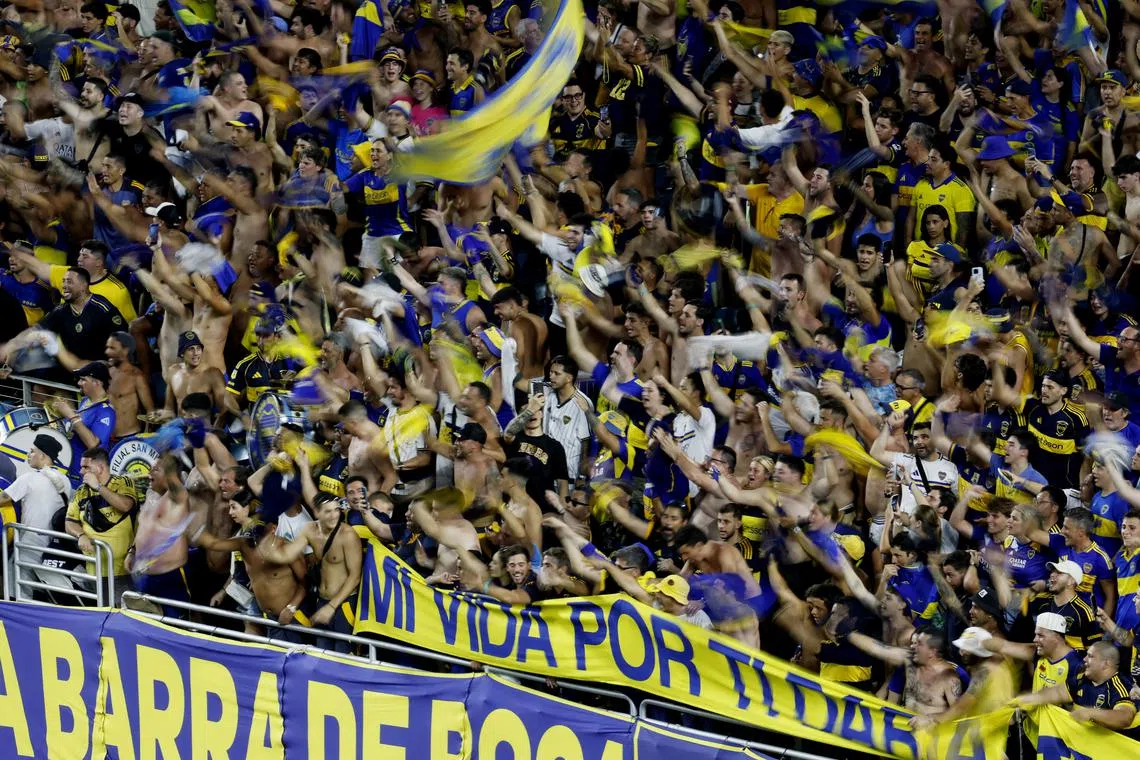South American fans light up Club World Cup, while some venues fall flat
Sign up now: Get ST's newsletters delivered to your inbox

Boca Juniors fans during the Argentinian giants' Club World Cup clash with Bayern Munich.
PHOTO: REUTERS
Follow topic:
MIAMI – Partying South American fans may have set the Club World Cup alight but unfortunately for hosts the United States, that carnival-like atmosphere has not swept across the country as some matches are being contested in front of modest crowds.
Global governing body Fifa had hoped the expanded version of the tournament featuring many of the world's top clubs would build enthusiasm for football in a country historically ambivalent to the beautiful game, as the US prepares to co-host the 2026 World Cup with Canada and Mexico.
With some 1.5 million tickets sold only days into the tournament, a chasm remains between the “haves” and the “have-nots” of the host cities.
In just two games, Argentinian giants Boca Juniors have taken Miami’s Hard Rock Stadium by storm, turning it into their own “Bombonera” outpost, filling it with a passion unmatched at this Club World Cup.
The Boca fans made up the majority of the 55,574 spectators for their 2-2 draw with Benfica on June 16 and it was a similar story among the 63,587 supporters present for the 2-1 defeat by Bayern Munich on June 20.
“I’ve had a long career and experienced a lot. There are times I want to be a player and tonight was one of those times,” Bayern coach Vincent Kompany said after the Boca game.
“They (the Boca Juniors fans) are special. The crowd was hostile in the best possible way... that’s what I love about football. Many fans would pay to watch that.”
The atmosphere created by the Boca fans, along with the presence of Inter Miami’s Lionel Messi for the opening game of the tournament and the visit of Real Madrid, has made Miami Gardens the capital of football in the US with an average attendance of 60,626.
Hard Rock Stadium, which has hosted the Super Bowl six times, has a capacity of nearly 66,000.
Messi, meanwhile, was the architect of football history after his stunning free kick secured Miami a 2-1 win over Porto on June 19, marking the first time that a Concacaf team had defeated a European side in an official Fifa tournament.
With Botafogo pulling off a shock 1-0 win over Champions League winners Paris Saint-Germain and Flamengo beating Chelsea 3-1, it was a good first week for Brazilian clubs in the tournament that expanded to 32 teams from seven in the last edition.
“I love when I see Botafogo, all the Brazilian teams, Argentinian teams, how they celebrate, how they are together, I love them,” Manchester City manager Pep Guardiola told reporters.
“I like how all the games are tight, except one or two, and people are surprised, European teams lose. Welcome to the real world. Welcome to the real world my friends.”
Unsurprisingly, the super-sized field has produced some lopsided results, with Bundesliga champions Bayern thrashing Auckland City, a team made up of amateur players, 10-0 in their opener.
While some host cities have had no problem getting the party started, including Los Angeles, which welcomed 80,619 to the Rose Bowl for its first match of the tournament between PSG and Atletico Madrid, others have struggled.
A June 17 match between Ulsan HD and Mamelodi Sundowns kicked off around 7pm in Orlando in front of 3,412 fans at the 25,500-capacity Inter&Co Stadium, while a 6pm match in Cincinnati the next day between Pachuca and RB Salzburg brought in just 5,282 spectators at the 26,000-capacity TQL Stadium.
“The environment was a bit strange,” Chelsea manager Enzo Maresca said after the English Premier League team beat MLS side Los Angeles FC 2-0 in front of little more than 22,000 fans at Atlanta’s 71,000-capacity Mercedes-Benz Stadium on a Monday afternoon.
A big challenge for the organisers has been to fill the stands in enormous venues more often used for the US’ national addiction – NFL football.
While smaller, football-specific stadiums abound in the US, the Club World Cup gives the organisers a chance to test out some of the venues Fifa expects to be filled to the brim at the 2026 World Cup.
If Fifa was hoping that locals would snap up tickets to watch a world-class football tournament on their doorstep, the evidence suggests it will be the travelling fans, rather than Americans, who will be scrambling to secure seats for next year’s World Cup. REUTERS

